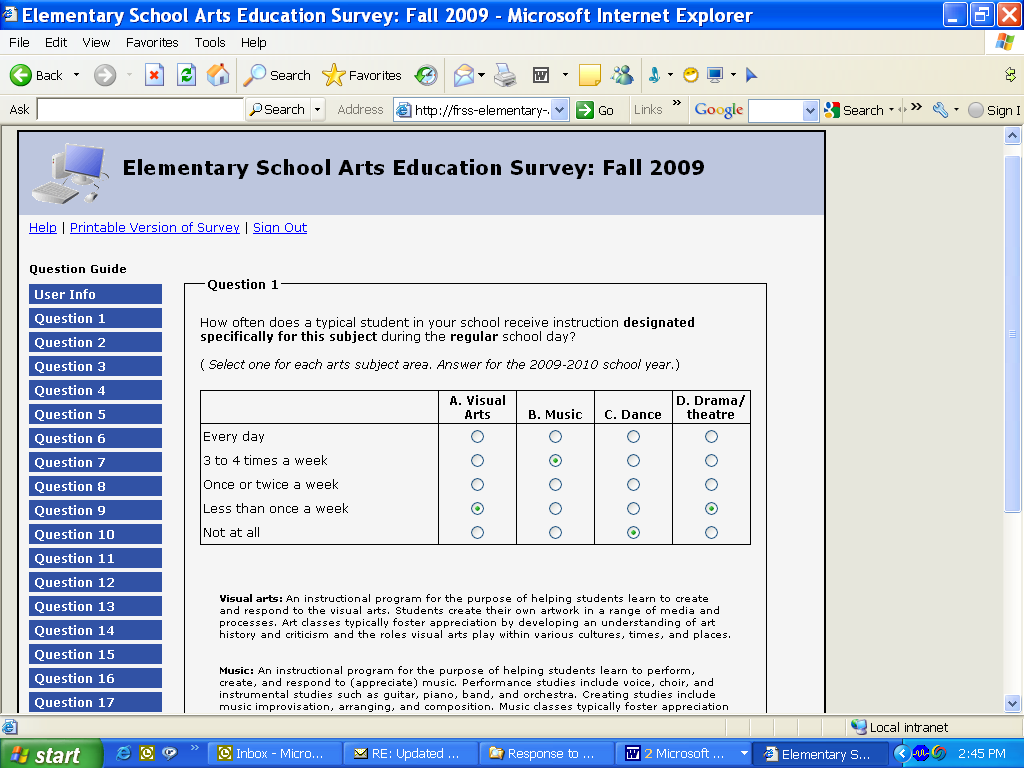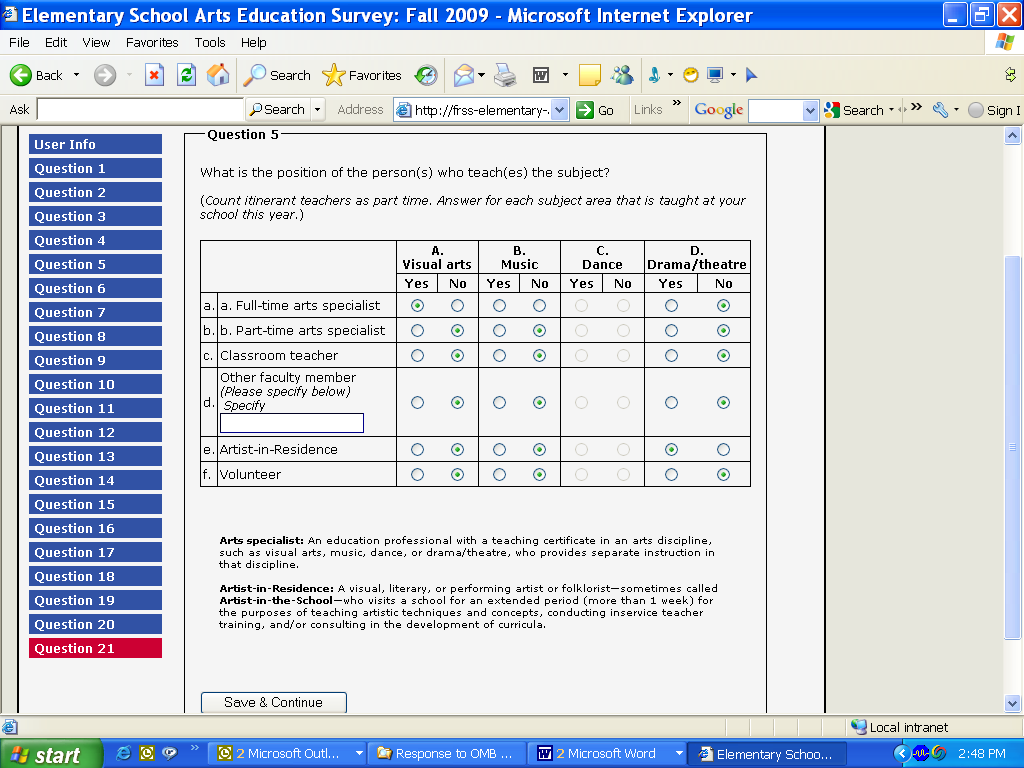Final ED Response to OMB Questions 8-17-09
Response to OMB 8-17-09.doc
Fast Response Survey System (FRSS) 100-103 - Arts Education in Public Elementary and Secondary Schools
Final ED Response to OMB Questions 8-17-09
OMB: 1850-0867
Response to Additional OMB Questions
Fast Response Survey System (FRSS) 100-103 –
Arts Education in Public Elementary and Secondary Schools
1850-New
August 17, 2009
Question 1 from OMB: Combined Schools: considering that combined schools are included in both the elementary and secondary school sampling frames, will projections of totals be made either for elementary or secondary schools individually, or for elementary and secondary schools as a combined group? If so, how will inclusions of combined schools in both strata be accounted for?
Response from NCES: Although a combined school will be included in both strata, it will be selected in a manner that ensures that it is selected for one and only one level. This is referred to as sampling without replacement. The sampling weights for the combined schools will be computed to account for the sampling-without-replacement process as follows. Let Pr(E) = the probability of selecting a combined school for the elementary survey. If it is selected for the elementary survey, it is taken out of the frame for the secondary survey. The remaining schools are then selected with probability Pr(S)/[1-Pr(E)] for the secondary survey, where Pr(S) is the desired probability of selecting the combined school for the secondary survey. The overall probability of selecting the school for the secondary survey is [1-Pr(E)] * Pr(S)/[1-Pr(E)] = Pr(S). The unbiased base weight for a combined school that is selected for the elementary survey is 1/Pr(E), and similarly, the unbiased base weight for a combined school that is selected for the secondary survey is 1/Pr(S).
Projections of totals can be made for elementary and secondary schools separately, with combined schools included either in the elementary or secondary group, depending on how they were sampled. For example, a single projection can be made of the number of elementary schools that provide arts courses at the elementary level and combined schools that were sampled as elementary schools and also provide arts courses at the elementary level. Similarly, a single projection can be made of the number of secondary schools that provide arts courses at the secondary level and combined schools that were sampled as secondary schools and also provide arts courses at the secondary level. Although the physical structure housing the combined school appears in both frames, it is considered to be two separate schools for the purpose of these projections. In other words, the goal is not to estimate the total number of physical structures, but rather the separate instructional entities defined by level; thus, no duplication occurs when the results are presented in this way. Projections of the number of arts teachers and the classes they teach can also be made in a similar fashion.
Question 2 from OMB: Web Survey: are there any changes in the format, design, or questions in the web presentation of the survey as compared to the mail version?
Response from NCES: As with past FRSS surveys, the web survey is designed to reflect the format and content of the paper survey. Thus, the questions for the web surveys and the look and feel of the surveys are essentially the same as the paper version, except for slight but necessary differences in format for a few grid questions (questions 1-6 in the elementary survey and questions 1-10 in the secondary survey). In keeping with standard web design practice, it was necessary to split these grids into separate web screens for each question or set of questions and repeat the column headers for each web screen. It was also necessary to use the "Yes/No" column header for question 5 of the elementary web survey instead of repeating "Yes/No" options for each part (a) through (f) of the question. We feel that these slight format differences do not change the meaning or interpretation of the questions because the content and question wording has essentially remained the same. Examples of the web screens for questions 1 and 5 of the elementary survey are provided below. Please note that if a respondent answers “Not at all” for a subject area in question 1, the column for that subject area will be grayed out in question 5 and the respondent will not be allowed to provide an answer for that column (i.e., this corresponds to the respondent skipping question 5 in the paper version).
Web screens for question 1 and 5 in online version of elementary school survey

NOTE: We will change the instruction to read “Answer for this school year.” to make the sentence consistent with the paper version)

Questions 1 through 6 in paper version of elementary school survey
(Incorporating changes from communication with OMB so far)
PLEASE READ THE FOLLOWING INSTRUCTIONS.
Questions 1 through 6 of this survey ask a series of questions about instruction at your school this school year in the following arts subjects: visual arts, music, dance, and drama/theatre. Before answering the questions, please refer to the definitions on the definitions page. Then answer question 1 for the first subject listed. If the answer to question 1 for an arts subject is 5 (“Not at all”), then skip questions 2 through 6 for that subject.
Question |
A. Visual arts |
B. Music |
C. Dance |
D. Drama/ theatre |
1. How often does a typical student in your school receive instruction designated specifically for this subject during the regular school day? (Circle one.) |
|
|
|
|
Every day |
1 |
1 |
1 |
1 |
3 or 4 times a week |
2 |
2 |
2 |
2 |
Once or twice a week |
3 |
3 |
3 |
3 |
Less than once a week |
4 |
4 |
4 |
4 |
Not at all |
5 |
5 |
5 |
5 |
2. Approximately how many minutes is a typical class or period of instruction in the subject? |
_______ |
_______ |
_______ |
_______ |
3. What is the duration of the class, i.e., does a typical student receive instruction throughout the school year or for some portion of the year? (Circle one.) |
|
|
|
|
Entire school year |
1 |
1 |
1 |
1 |
Half the school year |
2 |
2 |
2 |
2 |
One-quarter of the school year |
3 |
3 |
3 |
3 |
Less than one-quarter of the school year |
4 |
4 |
4 |
4 |
Other (Describe) |
5 |
5 |
5 |
5 |
4. Which of the following statements best describes the space used for teaching the subject at your school this year? (Circle one.) |
|
|
|
|
Dedicated room(s) with special equipment |
1 |
1 |
1 |
1 |
Dedicated room(s) with no special equipment |
2 |
2 |
2 |
2 |
Gymnasium, auditorium, or cafeteria |
3 |
3 |
3 |
3 |
Regular classrooms only |
4 |
4 |
4 |
4 |
Other (Specify) |
5 |
5 |
5 |
5 |
5. What is the position of the person(s) who teach(es) the subject? (Count itinerant teachers as part time.) (a) Full-time arts specialist (b) Part-time arts specialist (c) Classroom teacher (d) Other faculty member (Specify) (e) Artist-in-Residence (f) Volunteer |
Yes No Yes No Yes No Yes No Yes No Yes No |
Yes No Yes No Yes No Yes No Yes No Yes No |
Yes No Yes No Yes No Yes No Yes No Yes No |
Yes No Yes No Yes No Yes No Yes No Yes No |
6. Does your district have a written curriculum guide in the subject that your teachers are expected to follow? |
Yes No
|
Yes No
|
Yes No
|
Yes No
|
Question 3 from OMB: Arts Specialist/Certified (credentialed) Specialist Distinction: OMB still has concerns that the distinction between these definitions may not resonate with respondents. Via pretesting or other means, have you been able to demonstrate that respondents were able to accurately discriminate between these two terms?
Response from NCES: As noted in the third paragraph of our earlier response to this question, we will drop the second term “certified (credentialed) specialist” from all surveys and retain only the term, “arts specialist.” Thus, in all school and teacher surveys, we will refer only to arts specialist and retain the definition for this term (see our response to question 7 from OMB in the previous memo).
This means that respondents will not have to differentiate between two definitions. During survey development, respondents did not report any problems because they probably assumed that the terms could be used interchangeably.
Question 4 from OMB: Q7/Q8: a proposed compromise would be to add an option on Q7 (perhaps "j") where a respondent could indicate that Drama/Theater and Dance are not taught at their school, but would not skip the question.
Response from NCES: We do not think the proposed compromise to add an option “J” in question 7 of the elementary survey will work because of the following reasons.
Adding a single option (part J) will not work because, in some schools, drama/theatre may be taught but not dance (and vice versa).
Adding two separate options for drama/theatre and dance will make the question too complex because it already includes an option for an open-ended response. In the 1999-2000 survey, only a handful of elementary schools did not check "Yes" for any of the options (a) through (c) for drama/theatre and options (e) through (h) for dance. These schools used the open-ended option to indicate that drama/theatre and dance were not included in any program of study at the school.
It is awkward to add options that are worded in the negative format when the responses to this statement are in "Yes/No" response format. In other words, it could be confusing for respondents to answer "Yes" to a statement that reads "Dance is NOT taught at my school" (e.g., it is difficult to determine whether the respondent who checked “No” really meant “No, dance is not taught at my school). These negative statements are generally added as check boxes or as separate skip questions instead of part of grid questions that have "Yes/No" responses. However, for reasons stated earlier, adding check boxes could run the risk of respondents misinterpreting the statement to mean that drama/theatre or dance are not taught as SEPARATE subjects at the school.
Adding two check boxes (or separate options) will make the question too complex and require additional space that is not available in the survey.
| File Type | application/msword |
| File Title | From OMB |
| Author | Laurie Lewis |
| Last Modified By | #Administrator |
| File Modified | 2009-08-17 |
| File Created | 2009-08-14 |
© 2025 OMB.report | Privacy Policy